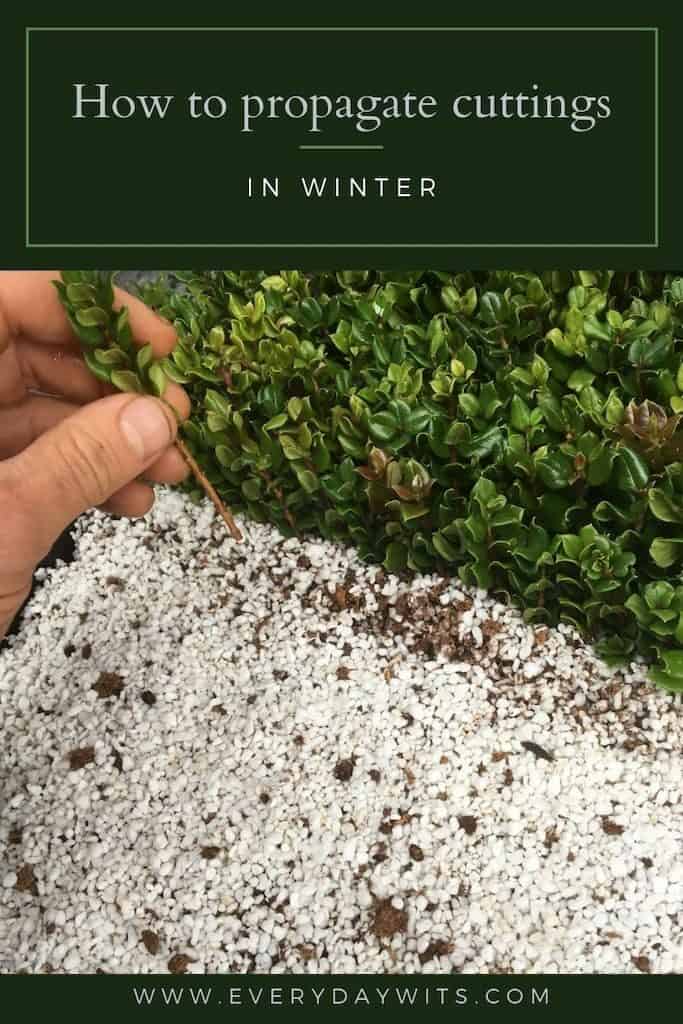There are many plants that can be propagated during winter. We often take cuttings during winter as it’s a quiet time in the nursery. Most people may assume that it’s simply too cold to take cuttings during the winter months, however there are quite a lot of plant species where winter propagation is the perfect time.
Whenever we are taking plant cuttings we use a mixture of perlite and peat moss. Many of the cuttings taken in winter could be planted direct into soil, or a mix of soil and sand. We propagate plants for a living and we can say without hesitation that cuttings placed into perlite and peat moss will have a superior success rate.
Perlite and peat moss are very inexpensive, you might as well use what the professionals use. We mix 9 parts perlite to 1 part peat moss. We like to put the mix into a seedling tray or you could use a pot, or any other container that has good drainage.
Taking hardwood cuttings from deciduous trees and shrubs is the most common winter cuttings. These can be food crops such as: Blackberry’s (we like the thornless kind), mulberries, blueberries, kiwi fruit, nectarines, peaches, apricots and countless others.
Then you have popular deciduous ornamental trees and shrubs like: Roses, hydrangeas, wisteria and maples. But it’s not only deciduous trees and shrubs that can be propagated during winter there are many evergreens that can be highly successful as winter cuttings.
Some of our common evergreen winter cuttings are: Buxus (box plant), Bay trees, Climbing jasmine, Portugal laurel and Camellias. There are also fast growing flowering perennials such as: Seaside daisy, Brachyscome, Scaevola, Violets and so many more that can be propagated during winter.
Protection
All cuttings will perform better if given protection from the elements. During the rooting phase cuttings are very vulnerable to drying out. Now just cause it’s winter doesn’t mean the cuttings aren’t vulnerable.
Wind can quickly dry cuttings out even cold winter winds. Frosts will also dry your cuttings out. During a frost the moisture within the stem of a plant is drawn out and freezes, this can cause a small stem like a cutting to shrivel up and die.
Some people like to cover their cuttings in plastic wrap. When doing this on a small scale such as a pot or even the seedling trays, I find the small volume of area to be too vulnerable to massive temperature fluctuations. The confined area also lacks airflow which can lead to fungus and disease.
I much prefer a more open, well ventilated, protected area. For us that’s our poly tunnel, but I’ve also used our porch and the kitchen windowsill. Cold frames are also another great option. So long as the area is well lit, frost free, well ventilated and offers wind protection you’re set.
Bottom heat
Many professional growers will apply bottom heat to their cuttings to help stimulate quicker root growth. Nowadays it’s very affordable for the home gardener to also use heat mats.
The use of bottom heat simulates what happens in spring as the temperature of the soil warms up. Applying heat to the bottom of the cutting can trick the plants into believing spring is here and it’s time to start growing.
Some plants such as blueberries really need to have that bottom heat to produce viable cuttings.
Water
People often want to know how often they need to water their cuttings. There’s really no one size fits all answer. I personally feel that watering cuttings during the winter is harder than watering cuttings in summer.
In the summer the cuttings can basically be watered everyday without any issues. Winter is much harder to judge. Generally cuttings taken in winter will develop roots much slower and the weather is obviously much cooler.
Because of this, overwatering is a risk. When cuttings are overwatered they will begin to rot or fungus will develop. The trick is to keep the perlite, peat moss or other media moist (not wet!). I also recommend you don’t mist the cuttings!
During summer it’s ok to mist the cuttings as the water will quickly evaporate and not remain on the cutting for extended periods of time. In winter the water doesn’t evaporate and again can lead to a fungus outbreak.
Another watering tip is to only water in the morning on bright sunny days. Again this is to ensure the cuttings aren’t kept wet for an extended period of time. If you water them in the afternoon or on cloudy days, they may not dry, until the next day! This is far too long.
Remember just keep the mix which the cuttings are in moist, not the cuttings themselves. This will greatly improve success rates and avoid any disease, rot or fungus.
Time frame
Being winter the time taken for the cuttings to strike is much longer. Generally it’s going to take 2-4 months for roots to develop on a cutting taken during winter. This is due to temperatures and light conditions.
Most plants understand what season it is based on the light. As the days become longer most plants will begin to generate new growth, it’s during this time that our winter cuttings will also start to move.
With this knowledge it can be tempting to wait until the end of winter to take the cuttings, however i find that it’s better to allow the buds to develop in the propagation mix as opposed to on the tree or shrub.
My theory being that the cutting understands its predicament, it needs to generate roots first before it can grow. A cutting taken close to spring was until recently attached to the shrub or tree and had an extensive root system, now the weather is warming up and it doesn’t have a root system. I feel this may lead to too much shock and a far less viable cutting.
Remember adding bottom heat can also help trick the cuttings into believing spring is here. Another trick some propagators use are growing lights, this is not something we personally do. Our climate is temperate enough that winter isn’t too long.
Summary
Hopefully this quick write up has shown that even during the winter months there are still many plants that can be propagated using cuttings.
For full tutorials on all the plants we propagate in our nursery check out the propagation page. And if this kind of stuff interests you be sure to subscribe to our newsletter.

